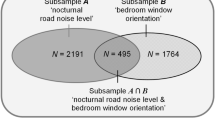Abstract
Objectives
To examine the risk of sleep problems associated with work stress (job strain, job demands, and decision authority), worries and pain and to investigate the synergistic interaction between these factors and traffic noise.
Methods
Sleep problems and predictor variables were assessed in a cross-sectional public health survey with 12,093 respondents. Traffic noise levels were assessed using modelled A-weighted energy equivalent traffic sound levels at the residence. The risk of sleep problems was modelled using multiple logistic regression analysis.
Results
With regard to sleep problems not attributed to any external source (general sleep problems), independent main effects were found for traffic noise (women), decision authority (women), job strain, job demands, suffering from pain or other afflictions, worries about losing the job, experiencing bullying at work, having troubles paying the bills, and having a sick, disabled, or old relative to take care of (women). Significant synergistic effects were found for traffic noise and experiencing bullying at work in women. With regard to sleep problems attributed to traffic noise, strong synergistic interactions were found between traffic noise and, respectively, job demands (men), having pain or other afflictions, taking care of a sick, old, or disabled relative, and having troubles paying the bills. Main effects were found for worries about losing the job, experiencing bullying at work, job strain (men), and decision authority (men). Synergistic interactions could potentially contribute with 10–20% of the sleep problems attributed to traffic noise in the population.
Conclusions
Work stress, pain, and different worries were independently associated with general sleep problems and showed in general no synergistic interaction with traffic noise. In contrast, synergistic effects between traffic noise and psychological factors were found with regard to sleep problems attributed to traffic noise. The synergy may contribute significantly to sleep problems attributed to traffic noise in the population.


Similar content being viewed by others
References
Åkerstedt T, Nilsson PM (2003) Sleep as restitution: an introduction. J Intern Med 254:6–12
Åkerstedt T, Knutsson A, Westerholm P, Theorell T, Alfredsson L, Kecklund G (2002) Sleep disturbances, work stress and work hours: a cross-sectional study. J Psychosom Res 53:741–748
Åkerstedt T, Knutsson A, Westerholm P, Theorell T, Alfredsson L, Kecklund G (2004) Mental fatigue, work and sleep. J Psychosom Res 57:427–433
Arber S, Bote M, Meadows R (2009) Gender and socio-economic patterning of self-reported sleep problems in Britain. Soc Sci Med 68:281–289
Ardö J (2005) Trafik, människor och miljö i Skåne. GIS Centre at Lund University, Lund. Ref Type: Report
Basner M, Müller U, Elmenhorst E-M, Kluge G, Griefahn B (2008) Aircraft noise effects on sleep: a systematic comparison of EEG awakenings and automatically detected cardiac activations. Physiol Meas 29:1089–1103
Basta M, Chrousos GP, Vela-Bueno A, Vgontzas AN (2007) Chronic insomnia and stress system. Sleep Med Clin 2:279–291
Bendtsen H (1999) The nordic prediction method for road traffic noise. Sci Total Environ 235:331–338
Björk J, Ardö J, Stroh E, Lövkvist H, Östergren PO, Albin M (2006) Road traffic noise in southern Sweden and its relation to annoyance, disturbance of daily activities and health. Scand J Work Environ Health 32:392–401
Canivet C, Östergren P-O, Choi B, Nilsson P, Sillén Ua, Moghadassi M, Karasek R, Isacsson SO (2008) Sleeping problems as a risk factor for subsequent musculoskeletal pain and the role of job strain: results from a one-year follow-up of the Malmö shoulder neck study cohort. Int J Behav Med 15:254–262
Chang PP, Ford DE, Mead LA, Cooper-Patrick L, Klante G (1997) Insomnia in young men and subsequent depression. The Johns Hopkins precursors study. Am J Epidemiol 146:105–114
Chen YY, Kawachi I, Subramanian SV, Acevedo-Garcia D, Lee YJ (2005) Can social factors explain sex differences in insomnia? Findings from a national survey in Taiwan. J Epidemiol Community Health 59:488–494
Chrousos GP (2007) Organization and integration of the endocrine system. Sleep Med Clin 2:125–145
Chrousos GP (2009) Stress and disorders of the stress system. Nat Rev Endocrinol 5:374–381
Fahlén G, Knutsson A, Peter R, Åkerstedt T, Nordin M, Alfredsson L, Westerholm P (2006) Effort-reward imbalance, sleep disturbances and fatigue. Int Arch Occup Environ Health 79:371–378
Gangwisch JE, Malaspina D, Boden-Albala B, Heymsfield SB (2005) Inadequate sleep as a risk factor for obesity: analyses of the NHANES I. Sleep 28:1289–1296
Greenland S (2008) Applications of stratified analysis methods. In: Rothman KJ, Greenland S, Lash TL (eds) Modern epidemiology. Lippincott Williams & Wilkins, Philadelphia, pp 283–302
Greenland S, Lash TL, Rothman KJ (2008) Concepts of Interaction. In: Rothman KJ, Greenland S, Lash TL (eds) Modern epidemiology. Lippincott Williams & Wilkins, Philadelphia, pp 71–83
Griefahn B, Marks A, Robens S (2006) Noise emitted from road, rail and air traffic and their effects on sleep. J Sound Vib 295:129–140
Guilleminault C, Davé R (2003) Upper airway resistance syndromes, insomnia, and functional somatic syndromes. Chest 123:12–14
Halász P, Terzano M, Parrino L, Bódizs R (2004) The nature of arousal in sleep. J Sleep Res 13:1–23
Harrison Y, Horne JA (1999) One night of sleep loss impairs innovative thinking and flexible decision making. Organ Behav Hum Decis Process 78:128–145
Hoffman B, Robra BP, Swart E (2003) Soziale Ungleichheit und Strassenlärm im Wohnumfeld—eine Auswertung des Bundesgesundheitssurveys [Social inequality and noise pollution by traffic in the living environment—an analysis by the German federal health survey (Bundesgesundheitssurvey)]. Gesundheitswesen 35:393–401
Hosmer DW, Lemeshow S (1992) Confidence interval estimation of interaction. Epidemiology 3:452–456
Jones BE (2003) Arousal systems. Front Biosci 8:s438–s451
Kalilani L, Atashili J (2006) Measuring additive interaction using odds ratios. Epidemiol Perspect Innov 3:5
Kalimo R, Tenkanen L, Härma M, Poppius E, Heinsalmi P (2000) Job stress and sleep disorders: findings from the helsinki heart study. Stress Med 16:65–75
Karasek R, Brisson C, Kawakami N, Houtman I, Bongers P, Amick B (1998) The Job Content Questionnaire (JCQ): an instrument for internationally comparative assessments of psychosocial job characteristics. J Occup Health Psychol 3:322–355
Klink M, Quan SF (1997) Prevalence of reported sleep disturbances in a general adult popluation and their relationship to obstructive airways diseases. Chest 91:540–546
Kyle SD, Morgan K, Espie CA (2010) Insomnia and health-related quality of life. Sleep Med Rev 14:69–82
Lavigne G, Zucconi M, Castronovo C, Manzini C, Marchettini P, Smirne S (2000) Sleep arousal response to experimental thermal stimulation during sleep in human subjects free of pain and sleep problems. Pain 84:283–290
Leineweber C, Kecklund G, Janszky I, Åkerstedt T, Orth-Gomer K (2003) Poor sleep increases the prospective risk for recurrent events in middle-aged women with coronary disease. The Stockholm female coronary risk study. J Psychosom Res 54:121–127
Lin JS (2000) Brain structures and mechanisms involved in the control of cortical activation and wakefulness, with emphasis on the posterior hypothalamus and histaminergic neurons. Sleep Med Rev 4:471–503
Linton SJ (2004) Does work stress predict insomnia? A prospective study. Br J Health Psychol 9:127–136
Meerlo P, Sgoifo A, Suchecki D (2008) Restricted and disrupted sleep: effects on autonomic function, neuroendocrine stress systems and stress responsivity. Sleep Med Rev 12:197–210
Middelkoop HAM, Smilde-van den Doel DA, Neven AK, Kamphuisen HAC, Springer CP (1996) Subjective sleep characteristics of 1,485 males and females aged 50–93: effects of sex and age, and factors related to self-evaluated quality of sleep. J Gerontol 51A:M108–M115
Miedema HME, Vos H (2007) Associations between self-reported sleep disturbance and environmental noise based on reanalyses of pooled data from 24 studies. Behav Sleep Med 5:1–20
Nesse RM, Ellsworth PC (2009) Evolution, emotions, and emotional disorders. Am Psychol 64:129–139
Niedhammer I, David S, Degioanni S, Drummond A, Philip P, 143 occupational physicians (2009) Workplace bullying and sleep disturbances: findings from a large scale cross-sectional survey in the French working population. Sleep 32:1211–1219
Nilsson PM, Nilsson JA, Hedblad B, Berglund G (2001) Sleep disturbance in association with elevated pulse rate for prediction of mortality–consequences of mental strain? J Intern Med 250:521–529
Nilsson PM, Roost M, Engstrom G, Hedblad B, Berglund G (2004) Incidence of diabetes in middle-aged men is related to sleep disturbances. Diabetes Care 27:2464–2469
Öhrström E (2000) Sleep disturbances caused by road traffic noise—studies in laboratory and field. Noise Health 2:71–78
Ota A, Masue T, Yasuda N, Tsutsumi A, Mino Y, Ohara H (2005) Association between psychosocial job characteristics and insomnia: an investigation using two relevant job stress models–the demand-control-support (DCS) model and the effort-reward imbalance (ERI) model. Sleep Med 6:353–358
Persson R, Björk J, Ardö J, Albin M, Jakobsson K (2007) Trait anxiety and modeled exposure as determinants of self-reported annoyance to sound, air pollution and other environmental factors in the home. Int Arch Occup Environ Health 81:179–191
Posner J, Russell JA, Peterson BS (2005) The circumplex model of affect: an integrative approach to affective neuroscience, cognitive development, and psychopathology. Dev Psychopathol 17:715–734
Raschke F (2004) Aircraft noise effects on sleep: a systematic comparison of EEG awakenings and automatically detected cardiac activations. Noise & Health 6:15–26
Rosvall M, Khan A F, Nilsson M, Östergren P-O (2005) Hälsoförhållanden i Skåne. Folkhälsoenkät Skåne 2004. Universitetssjukhuset MAS, Malmö, Socialmedicinska enheten, Region Skåne. Ref Type: Report
Rugulies R, Norborg M, Sørensen TS, Knudsen LE, Burr H (2009) Effort-reward imbalance at work and risk of sleep disturbances. Cross-sectional and prospective results from the Danish Work Environment Cohort study. J Psychosom Res 66:75–83
Russell JA (1980) A circumplex model of affect. J Pers Soc Psychol 39:1161–1178
Saper CB, Cano G, Scammell TE (2005) Homeostatic, circadian, and emotional regulation of sleep. J Comp Neurol 493:92–98
Schwartz S, Andersson WM, Cole SR, Cornoni-Huntley J, Hays JC, Blazer D (1999) Insomnia and heart disease: a review of epidemiologic studies. J Psychosom Res 47:313–333
Siegel J (2004) Brain mechanisms that control sleep and waking. Naturwissenschaften 91:355–365
Statistics Sweden (2008) Har besvär med sömnen. Personer 16-84 år. http://www.scb.se/templates/tableorchart_____48627.asp. Accessed 11 Dec 2008. Stockholm, Statistics Sweden. Ref Type: Data File
Steptoe A, O’Donnell K, Marmot M, Wardle J (2008) Positive affect, psychological well-being, and good sleep. J Psychosom Res 64:409–415
Urponen H, Vuori I, Hasan J, Partinen M (1988) Self-evaluations of factors promoting and disturbing sleep: an epidemiological survey in Finland. Soc Sci Med 26:443–450
Vgontzas AN, Bixler EO, Wittman AM, Zachman K, Lin H-M, Vela-Bueno A, Kales A, Chrousos GP (2001) Middle-aged men show higher sensitivity of sleep to the arousing effects of corticotropin-releasing hormone than young men: clinical implications. J Clin Endocrinol Metab 86:1489–1495
Vgontzas AN, Lin H-M, Papaliaga M, Calhoun S, Vela-Bueno A, Chrousos GP, Bixler EO (2008) Short sleep duration and obesity: the role of emotional stress and sleep disturbances. Int J Obes 32:801–809
Acknowledgments
The Scania County Council is gratefully acknowledged for giving us access to the Scania 2004 survey.
Conflict of interest
The authors declare that they have no conflict of interest.
Author information
Authors and Affiliations
Corresponding author
Appendix
Appendix
Calculation of excess attributable fraction
Consider two interacting variables as a single variable with level low (both variables at low level) and high (both high), and RR is the relative risk of sleep problems at the high level. The attributable fraction of sleep problem cases among the exposed, AFE, is then:
Likewise, assume that RR* would be the relative risk if there was no interaction between the variables, and the corresponding attributable fraction is AFE* = (RR*− 1)/RR*. We define the excess attributable fraction of sleep problem cases among the exposed, EAFE, as the difference between these two attributable fractions:
RR and RR* are related through AP. Thus
where RR*11 = RR10 + RR01 − 1. Rearranging this expression for AP one reaches the relation RR*11 = RR11 × (1 − AP). Inserting this in the expression for EAFE (and making use of the identities RR = RR11 and RR* = RR*11), we arrive to the expression for EAFE used in this study:
Rights and permissions
About this article
Cite this article
Kristiansen, J., Persson, R., Björk, J. et al. Work stress, worries, and pain interact synergistically with modelled traffic noise on cross-sectional associations with self-reported sleep problems. Int Arch Occup Environ Health 84, 211–224 (2011). https://doi.org/10.1007/s00420-010-0557-8
Received:
Accepted:
Published:
Issue Date:
DOI: https://doi.org/10.1007/s00420-010-0557-8




